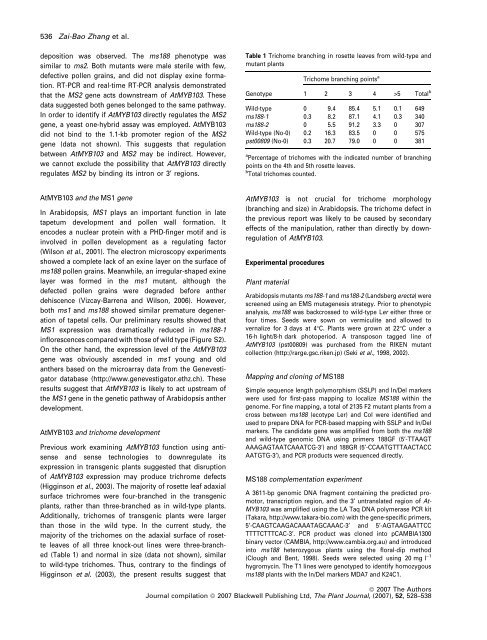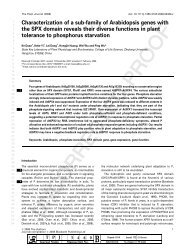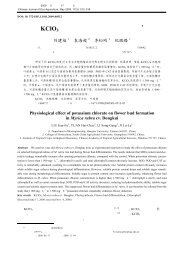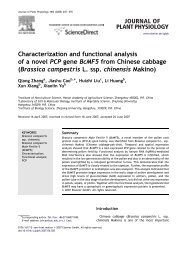Create successful ePaper yourself
Turn your PDF publications into a flip-book with our unique Google optimized e-Paper software.
536 Zai-Bao Zhang et al.<br />
deposition was observed. The ms188 phenotype was<br />
similar to ms2. Both mutants were male sterile with few,<br />
defective pollen grains, and did not display exine formation.<br />
RT-PCR and real-time RT-PCR analysis demonstrated<br />
that the MS2 gene acts downstream of AtMYB103. These<br />
data suggested both genes belonged to the same pathway.<br />
In order to identify if AtMYB103 directly regulates the MS2<br />
gene, a yeast one-hybrid assay was employed. AtMYB103<br />
did not bind to the 1.1-kb promoter region of the MS2<br />
gene (data not shown). This suggests that regulation<br />
between AtMYB103 and MS2 may be indirect. However,<br />
we cannot exclude the possibility that AtMYB103 directly<br />
regulates MS2 by binding its intron or 3¢ regions.<br />
Table 1 Trichome branching in rosette leaves from wild-type and<br />
mutant plants<br />
Genotype<br />
Trichome branching points a<br />
1 2 3 4 >5 Total b<br />
Wild-type 0 9.4 85.4 5.1 0.1 649<br />
ms188-1 0.3 8.2 87.1 4.1 0.3 340<br />
ms188-2 0 5.5 91.2 3.3 0 307<br />
Wild-type (No-0) 0.2 16.3 83.5 0 0 575<br />
pst00809 (No-0) 0.3 20.7 79.0 0 0 381<br />
a Percentage of trichomes with the indicated number of branching<br />
points on the 4th and 5th rosette leaves.<br />
b Total trichomes counted.<br />
AtMYB103 and the MS1 gene<br />
In Arabidopsis, MS1 plays an important function in late<br />
tapetum development and pollen wall formation. It<br />
encodes a nuclear protein with a PHD-finger motif and is<br />
involved in pollen development as a regulating factor<br />
(Wilson et al., 2001). The electron microscopy experiments<br />
showed a complete lack of an exine layer on the surface of<br />
ms188 pollen grains. Meanwhile, an irregular-shaped exine<br />
layer was formed in the ms1 mutant, although the<br />
defected pollen grains were degraded before anther<br />
dehiscence (Vizcay-Barrena and Wilson, 2006). However,<br />
both ms1 and ms188 showed similar premature degeneration<br />
of tapetal cells. Our preliminary results showed that<br />
MS1 expression was dramatically reduced in ms188-1<br />
inflorescences compared with those of wild type (Figure S2).<br />
On the other hand, the expression level of the AtMYB103<br />
gene was obviously ascended in ms1 young and old<br />
anthers based on the microarray data from the Genevestigator<br />
database (http://www.genevestigator.ethz.ch). These<br />
results suggest that AtMYB103 is likely to act upstream of<br />
the MS1 gene in the genetic pathway of Arabidopsis anther<br />
development.<br />
AtMYB103 and trichome development<br />
Previous work examining AtMYB103 function using antisense<br />
and sense technologies to downregulate its<br />
expression in transgenic plants suggested that disruption<br />
of AtMYB103 expression may produce trichrome defects<br />
(Higginson et al., 2003). The majority of rosette leaf adaxial<br />
surface trichromes were four-branched in the transgenic<br />
plants, rather than three-branched as in wild-type plants.<br />
Additionally, trichomes of transgenic plants were larger<br />
than those in the wild type. In the current study, the<br />
majority of the trichomes on the adaxial surface of rosette<br />
leaves of all three knock-out lines were three-branched<br />
(Table 1) and normal in size (data not shown), similar<br />
to wild-type trichomes. Thus, contrary to the findings of<br />
Higginson et al. (2003), the present results suggest that<br />
AtMYB103 is not crucial for trichome morphology<br />
(branching and size) in Arabidopsis. The trichome defect in<br />
the previous report was likely to be caused by secondary<br />
effects of the manipulation, rather than directly by downregulation<br />
of AtMYB103.<br />
Experimental procedures<br />
Plant material<br />
Arabidopsis mutants ms188-1 and ms188-2 (Landsberg erecta) were<br />
screened using an EMS mutagenesis strategy. Prior to phenotypic<br />
analysis, ms188 was backcrossed to wild-type Ler either three or<br />
four times. Seeds were sown on vermiculite and allowed to<br />
vernalize for 3 days at 4°C. Plants were grown at 22°C under a<br />
16-h light/8-h dark photoperiod. A transposon tagged line of<br />
AtMYB103 (pst00809) was purchased from the RIKEN mutant<br />
collection (http://rarge.gsc.riken.jp) (Seki et al., 1998, 2002).<br />
Mapping and cloning of MS188<br />
Simple sequence length polymorphism (SSLP) and In/Del markers<br />
were used for first-pass mapping to localize MS188 within the<br />
genome. For fine mapping, a total of 2135 F2 mutant plants from a<br />
cross between ms188 (ecotype Ler) and Col were identified and<br />
used to prepare DNA for PCR-based mapping with SSLP and In/Del<br />
markers. The candidate gene was amplified from both the ms188<br />
and wild-type genomic DNA using primers 188GF (5¢-TTAAGT<br />
AAAGAGTAATCAAATCG-3¢) and 188GR (5¢-CCAATGTTTAACTACC<br />
AATGTG-3¢), and PCR products were sequenced directly.<br />
MS188 complementation experiment<br />
A 3611-bp genomic DNA fragment containing the predicted promotor,<br />
transcription region, and the 3¢ untranslated region of At-<br />
MYB103 was amplified using the LA Taq DNA polymerase PCR kit<br />
(Takara, http://www.takara-bio.com) with the gene-specific primers,<br />
5¢-CAAGTCAAGACAAATAGCAAAC-3¢ and 5¢-AGTAAGAATTCC<br />
TTTTCTTTCAC-3¢. PCR product was cloned into pCAMBIA1300<br />
binary vector (CAMBIA, http://www.cambia.org.au) and introduced<br />
into ms188 heterozygous plants using the floral-dip method<br />
(Clough and Bent, 1998). Seeds were selected using 20 mg l )1<br />
hygromycin. The T1 lines were genotyped to identify homozygous<br />
ms188 plants with the In/Del markers MDA7 and K24C1.<br />
ª 2007 The Authors<br />
Journal compilation ª 2007 Blackwell Publishing Ltd, The Plant Journal, (2007), 52, 528–538








